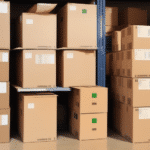How to Accurately Measure Box Dimensions
Accurate box measurements are essential for efficient shipping and inventory management. Properly measuring your boxes can help you avoid unnecessary shipping costs, prevent damage to contents, and ensure compliance with carrier regulations. This comprehensive guide will provide you with everything you need to know to measure box dimensions accurately.
Importance of Accurate Box Measurements in Shipping
Understanding the significance of precise box measurements is the first step toward optimizing your shipping process. Shipping costs are typically calculated based on both the weight and dimensions of a package. Inaccurate measurements can lead to:
- Increased Shipping Costs: Overestimated dimensions may result in higher fees from carriers.
- Product Damage: Incorrect sizes can cause boxes to shift during transit, potentially damaging the contents.
- Shipping Delays: Non-compliance with carrier size requirements can lead to package rejections or returns, causing delays.
According to the UPS 2023 Shipping Guide, accurate dimensional measurements can reduce shipping costs by up to 15% for businesses.
Methods for Measuring Box Dimensions
Traditional Measurement Tools
The most common methods for measuring box dimensions involve using basic tools such as rulers, measuring tapes, or calipers. The standard "length x width x height" method is widely used:
- Measure the length from one end to the other.
- Measure the width from one side to the other.
- Measure the height from the base to the top.
Alternatively, calipers can provide more precise measurements, especially for smaller or irregularly shaped boxes.
Advanced Measurement Techniques
For irregularly shaped boxes, the water displacement method can be effective. This involves:
- Filling a container with water.
- Submerging the box to measure the volume of water displaced.
This method is particularly useful for boxes that are not easily measured using traditional tools.
Essential Tools for Measuring Box Dimensions
Choosing the right tools is crucial for obtaining accurate measurements. Here are some essential tools:
- Measuring Tape: Ideal for flexible and large boxes.
- Ruler: Suitable for smaller, rigid boxes.
- Calipers: Provide precise measurements for detailed work.
- Digital Measurement Devices: Offer quick and accurate measurements using laser or ultrasonic technology.
For more information on selecting the appropriate tools, refer to the FedEx Packaging Guide.
Step-by-Step Guide to Measuring Box Dimensions
Follow these steps to ensure accurate measurements:
- Place the box on a flat, stable surface.
- Use a measuring tape or ruler to determine the length from one end to the other.
- Measure the width from one side to the other.
- Measure the height from the bottom to the top of the box.
- Multiply length, width, and height to calculate the total volume (cubic measurements).
Ensure all measurements are taken in the same unit (inches, centimeters, etc.) to maintain consistency.
Tips for Achieving Precise Measurements
- Always use the same measuring tool to maintain consistency.
- Measure the longest side first to ensure space for other measurements.
- Avoid compressing the box during measurement to prevent inaccuracies.
- Double-check each measurement to confirm accuracy.
Taking these precautions can significantly enhance the precision of your measurements.
Common Pitfalls in Measuring Box Dimensions
Avoid these common mistakes to ensure accuracy:
- Omitting the Height: Always include the height measurement.
- Measuring Exterior Instead of Interior: Ensure you're measuring the correct dimensions.
- Ignoring Irregularities: Account for any protrusions or bends in the box.
- Not Accounting for Material Thickness: Include the thickness of the box material in your measurements.
Measuring Irregularly-Shaped Boxes
For boxes that aren't standard rectangles, consider the following approach:
- Break the box down into simpler shapes (e.g., rectangles, triangles).
- Measure each individual shape separately.
- Sum the measurements to obtain the total dimensions.
Utilizing flexible measuring tapes or strings can help navigate curves and protrusions effectively.
Leveraging Technology for Accurate Measurements
Modern technology offers advanced solutions for measuring box dimensions:
- Smartphone Apps: Utilize your phone's camera to take and calculate measurements quickly.
- Laser Measuring Devices: Provide precise measurements with minimal effort.
- Automated Measurement Systems: Ideal for businesses handling high volumes, these systems integrate with conveyor belts to measure boxes automatically.
Implementing these technologies can streamline your measuring process and reduce human error.
Consistency in Box Measurements for Inventory Management
Maintaining consistent box dimensions is vital for effective inventory management. Benefits include:
- Accurate Space Allocation: Ensures efficient use of storage space.
- Reliable Inventory Tracking: Facilitates precise tracking and management of inventory levels.
- Improved Operational Efficiency: Streamlines packing and shipping processes.
According to the Supply Chain Dive 2023 Report, businesses that maintain consistent measurements see a 20% improvement in inventory accuracy.
Cost Savings Through Accurate Box Measurements
Precision in measuring box dimensions can lead to significant cost savings:
- Reduced Shipping Costs: Avoid overpaying for oversized packages by providing accurate dimensions.
- Minimized Product Damage: Prevent costly returns and replacements by ensuring proper packaging.
- Optimized Storage: Maximize storage space, reducing the need for additional storage solutions.
Research by Forbes indicates that businesses can save up to 10% on shipping costs annually through accurate dimension measurements.
Best Practices for Recording and Tracking Box Dimensions
Implementing a systematic approach to recording and tracking dimensions ensures consistency:
- Digital Databases: Use spreadsheets or specialized software to log box dimensions.
- Labeling: Clearly label each box with its measurements for easy reference.
- Regular Audits: Periodically verify measurements to maintain accuracy.
- Employee Training: Educate staff on proper measurement techniques and the importance of accuracy.
Adopting these practices can enhance data integrity and operational efficiency.
Conclusion
Accurate measurement of box dimensions is a critical component of successful shipping and inventory management. By employing the right tools, following systematic measurement methods, and leveraging modern technology, businesses can reduce costs, prevent product damage, and streamline their logistics operations. Consistent and precise measurements not only contribute to operational efficiency but also enhance customer satisfaction by ensuring timely and safe deliveries.
For more insights and tools on optimizing your shipping processes, visit the ShipScience Resources.




















